Impact of Meteorological Factors on the Wire Icing Thickness and Growth Rate in Mountain Areas under Dry and Wet Growth Patterns
Abstract
1. Introduction
2. Study Area, Data and Methodology
2.1. Study Area and Data Sources
2.2. Methodology
2.2.1. Makkonen Icing Growth Modeling
2.2.2. Methods for Extrapolating Liquid Water Content at Different Altitudes
3. Results
3.1. General Description of Wire Icing Events
3.2. Wire Icing Thickness and Growth Rate as a Function of Altitude under Different Micro Topographies
3.3. Relationship between Meteorological Elements and Altitude under Different Microtopographies during Icing Events
3.4. Correlation Analysis between Meteorological Factors and Icing Rate
3.5. Influence of Meteorological Elements on Wire Icing Growth Rate during Dry and Wet Growth Process
4. Further Analysis
5. Concluding Remarks
Author Contributions
Funding
Institutional Review Board Statement
Informed Consent Statement
Data Availability Statement
Conflicts of Interest
References
- Farzaneh, M. (Ed.) Atmospheric Icing of Power Networks; Springer Science & Business Media: Dordrecht, The Netherlands, 2008. [Google Scholar]
- Xu, S.K.; Zhao, J. Review of ice storm cases impacted seriously on power systems and de-icing technology. South. Power Syst. Technol. 2008, 2, 6. [Google Scholar]
- Hu, Y.; Hu, J.X.; Liu, T. Analysis and countermeasures for large area icing accident on power grid in northern China. Electr. Equip. 2008, 9, 1–4. [Google Scholar]
- Huang, B.; Xu, S.S.; Su, W.Y. Summary of research on icing of transmission lines. Insul. Surge Arresters 2012, 1, 27–32. [Google Scholar]
- Yang, H.; Yang, Y.; Shen, P.; Guo, T. Spatial correlation analysis of icing and geographical environment factors in Guizhou. Bull. Sci. Technol. 2018, 34, 49–52. (In Chinese) [Google Scholar]
- Wang, S.L.; Zhang, X. Impact of micro-terrain and micro-meteorology on transmission lines and countermeasures. Yunnan Electr. 2005, 6, 36–37. (In Chinese) [Google Scholar]
- Lu, J.Z.; Zeng, M.; Tian, L.; Luo, X.L.; Zeng, X.J. Microtopography based icing grades judging method for transmission lines. J. Electr. Power Sci. Technol. 2013, 28, 24–30. [Google Scholar]
- Liu, X.J.; Niu, S.J. Analysis of the causes for two high-voltage wire icing cases. J. Meteorol. Sci. 2016, 36, 230–235. [Google Scholar]
- Zhao, M.Y.; Xu, H.M. Inversion layer feature and its maintenance mechanism during ice weather over southern China in January of 2008. J. Meteorol. Sci. 2010, 30, 814–821. [Google Scholar]
- Huang, W.Y.; Dong, W.; Shen, X.Y.; Guo, C.Y.; Li, X.F.; Liang, P. Isentropic vortex and thermodynamic analysis of a cold wave cooling process. J. Meteorol. Sci. 2020, 40, 769–781. [Google Scholar]
- Ryerson, C.C. Atmospheric icing rates with elevation on northern New England mountains, USA. Arct. Alp. Res. 1990, 22, 90–97. [Google Scholar] [CrossRef]
- Jiang, X.L.; Du, Z.; Wang, H.Y.; Zhang, Z.J. Icing features of wire in Chongqing region. High Volt. Eng. 2011, 37, 3065–3069. (In Chinese) [Google Scholar]
- Drage, M.A.; Thiis, T.K. Large-scale measurements and numerical simulations of in-cloud icing around a mountain ridge. J. Wind Eng. Ind. Aerodyn. 2012, 104, 523–531. [Google Scholar] [CrossRef]
- Elizbarashvili, E.S.; Varazanashvili, O.S.; Tsereteli, N.S.; Elizbarashvili, M.E.; Kaishauri, M.N. Icing of wires in mountain areas of Georgia. Russ. Meteorol. Hydrol. 2012, 37, 567–569. [Google Scholar] [CrossRef]
- Lin, Z.G. Orographic Precipitation Climatology; China Science Publishing & Media Ltd.: Beijing, China, 1995. [Google Scholar]
- Wichura, B. The Spatial Distribution of Icing in Germany; German Meteorological Service, Regional Climate Office Potsdam: Potsdam, Germany, 2013. [Google Scholar]
- Zhang, X. Mechanism and countermeasures for ice-coated transmission line in micro-terrain and microclimate region. Power Syst. Technol. 2007, 31, 87–89. [Google Scholar]
- Luo, X.L. Study on Icing Grades Classification and dc De-Icing Scheme for Power Grid. Master’s Thesis, Changsha University of Science & Technology, Changsha, China, 2012. [Google Scholar]
- Makkonen, L. Estimating intensity of atmospheric ice accretion on stationary structures. J. Appl. Meteorol. Climatol. 1981, 20, 595–600. [Google Scholar] [CrossRef]
- Makkonen, L. Modeling of ice accretion on wires. J. Appl. Meteorol. Climatol. 1984, 23, 929–939. [Google Scholar] [CrossRef]
- Makkonen, L. Models for the growth of rime, glaze, icicles and wet snow on structures. Philos. Trans. R. Soc. Lond. Ser. A Math. Phys. Eng. Sci. 2000, 358, 2913–2939. [Google Scholar] [CrossRef]
- Jiang, S.; Ren, X.; Wu, J.R.; Huang, L. Research on algorithmic error analysis and model improvement technology of icing monitoring system in southern power grid. Power Syst. Big Data 2019, 22, 9–14. [Google Scholar]
- Finstad, K.J.; Lozowski, E.P.; Gates, E.M. A computational investigation of water droplet trajectories. J. Atmos. Ocean. Technol. 1958, 5, 160–170. [Google Scholar] [CrossRef]
- Han, X.; Jiang, X. Analysis of critical condition for dry and wet growth icing on insulators. Electr. Power Syst. Res. 2021, 192, 107006. [Google Scholar] [CrossRef]
- Sokolov, P.; Virk, M.S. Droplet distribution spectrum effects on dry ice growth on cylinders. Cold Reg. Sci. Technol. 2019, 160, 80–88. [Google Scholar] [CrossRef]
- Jiang, X.L. Transmission Line Icing Mechanism and the Three Gorges Region Icing Rule and Influence Factor Research. Ph.D. Thesis, Chongqing University, Chongqing, China, 1997. [Google Scholar]
- Zhang, J.; He, Q. Study on the influencing factors of the frozen coefficient under icing on the transmission lines. J. North China Electr. Power Univ. 2016, 43, 50–55. [Google Scholar]
- Yao, D.G.; Han, Y.X.; Liu, S.F. Analysis of the Causes of Transmission Line Ice-Covering Disaster and Forecasting and Early Warning Technology; China Meteorological Press: Beijing, China, 2022. [Google Scholar]

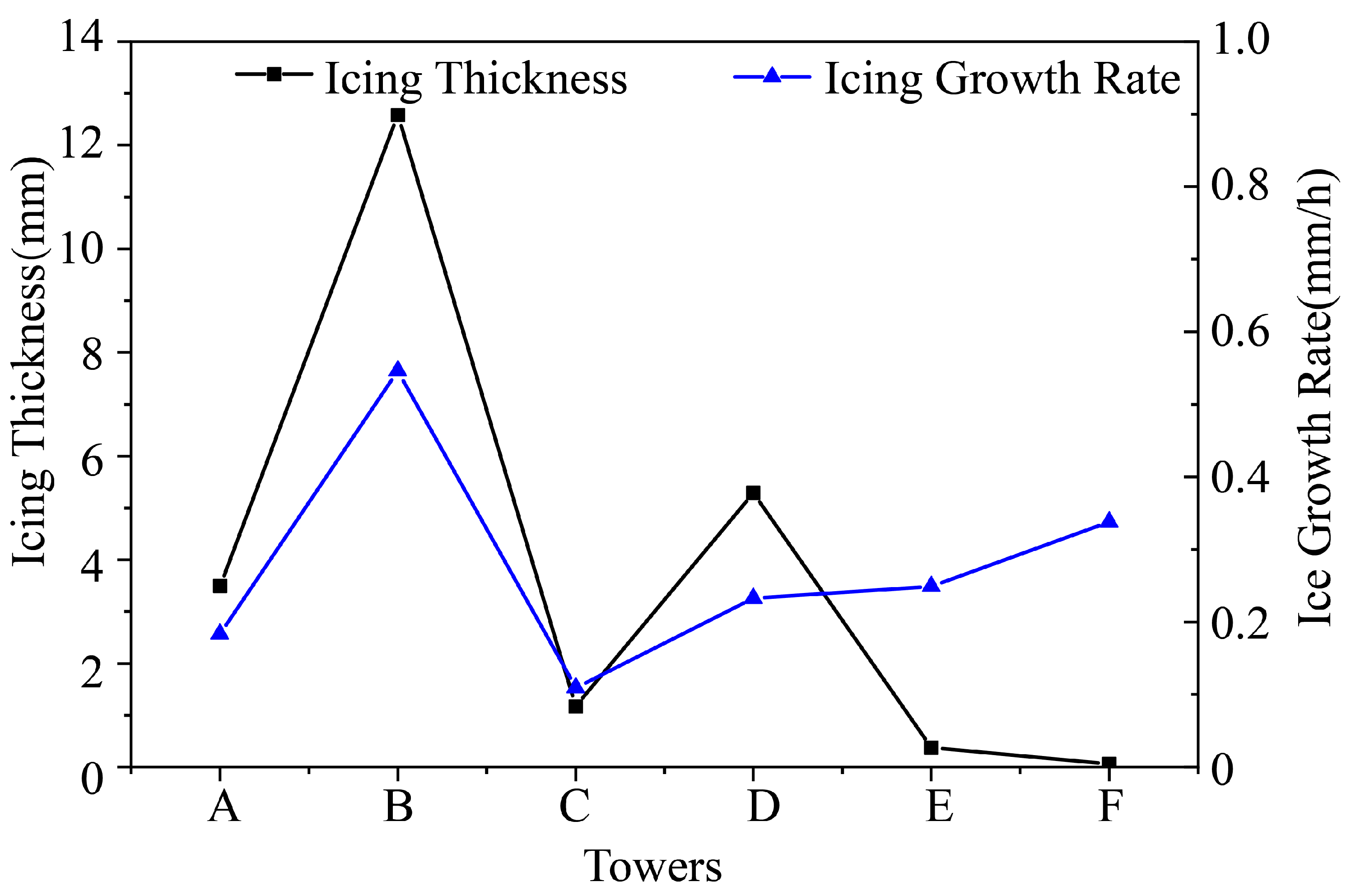
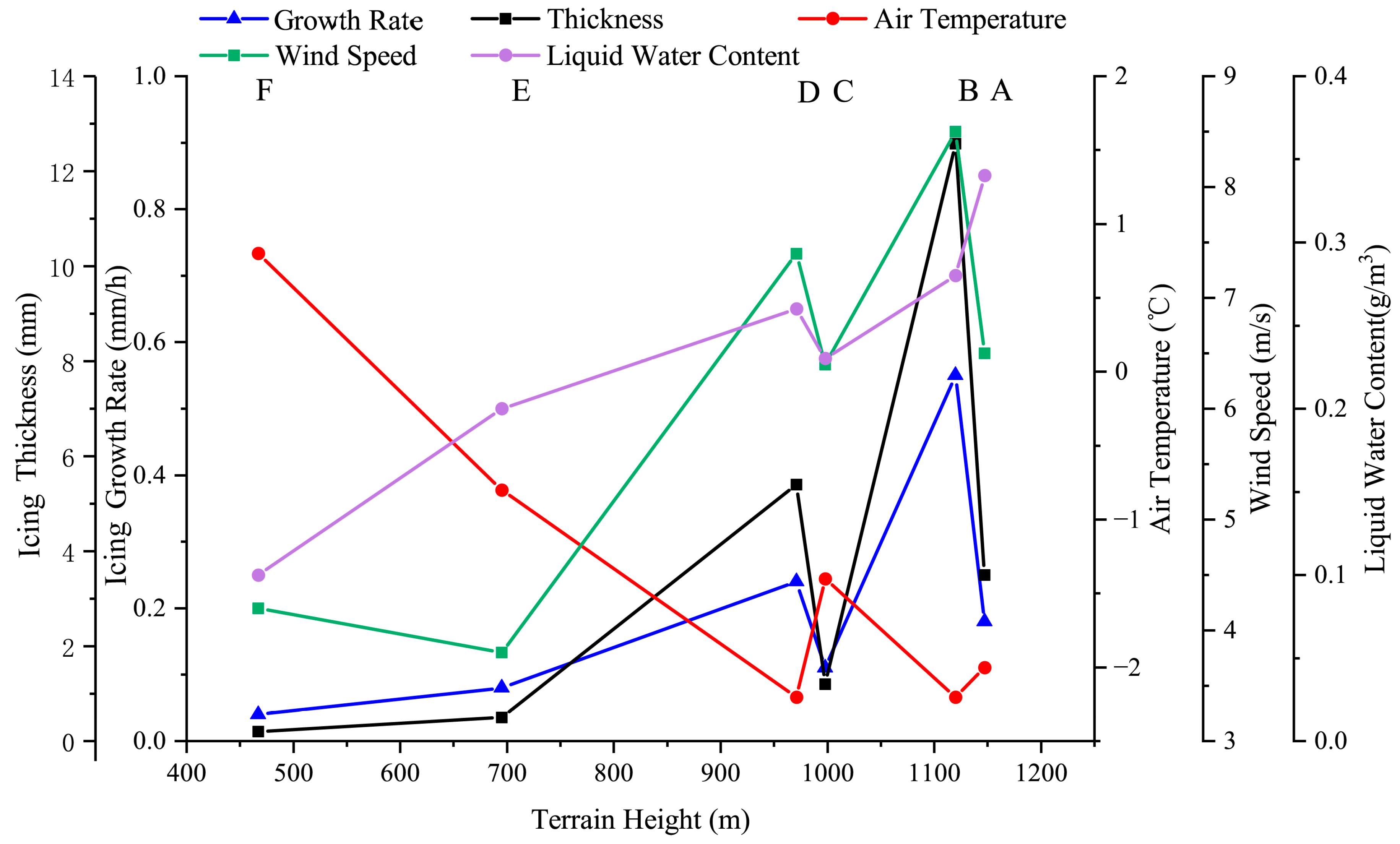

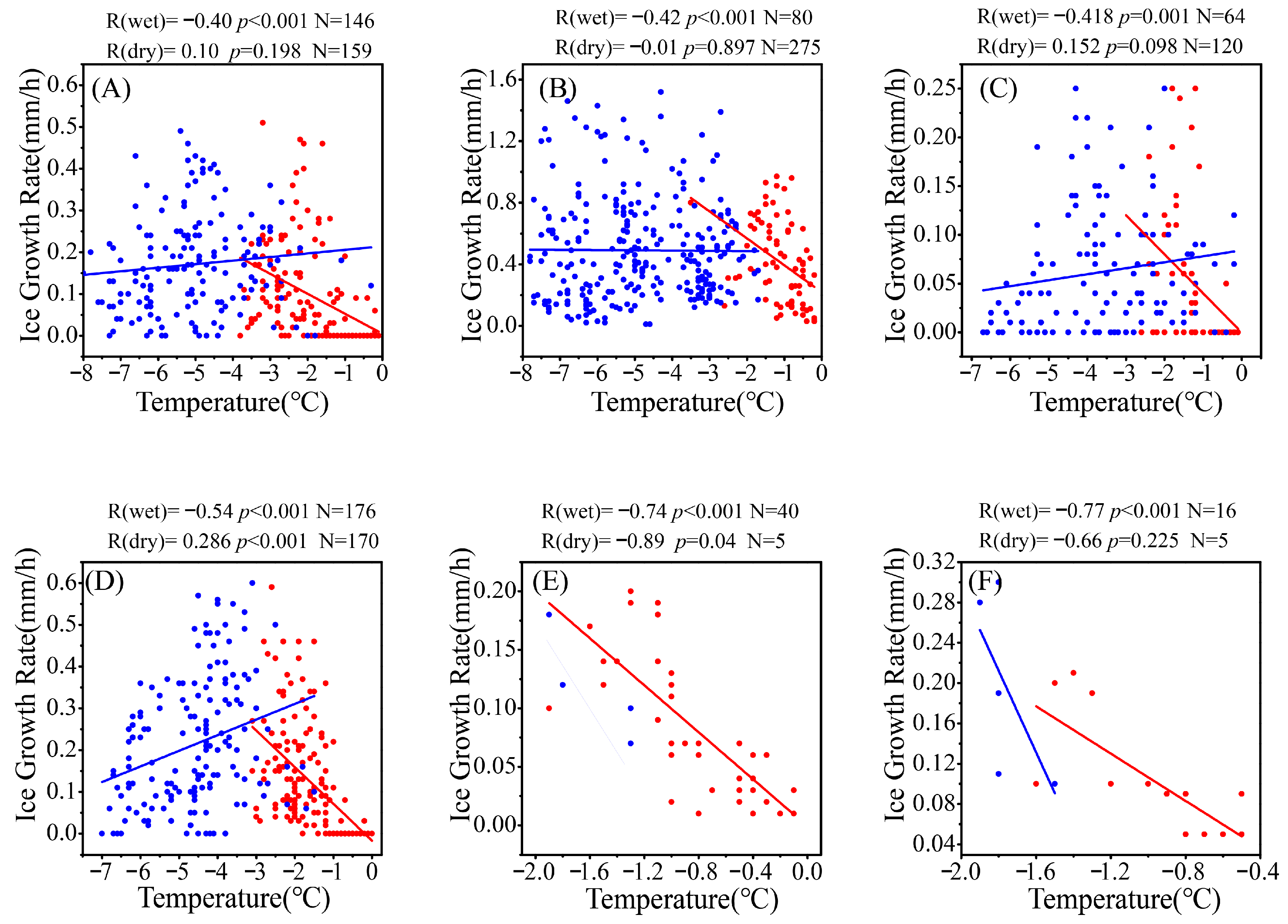
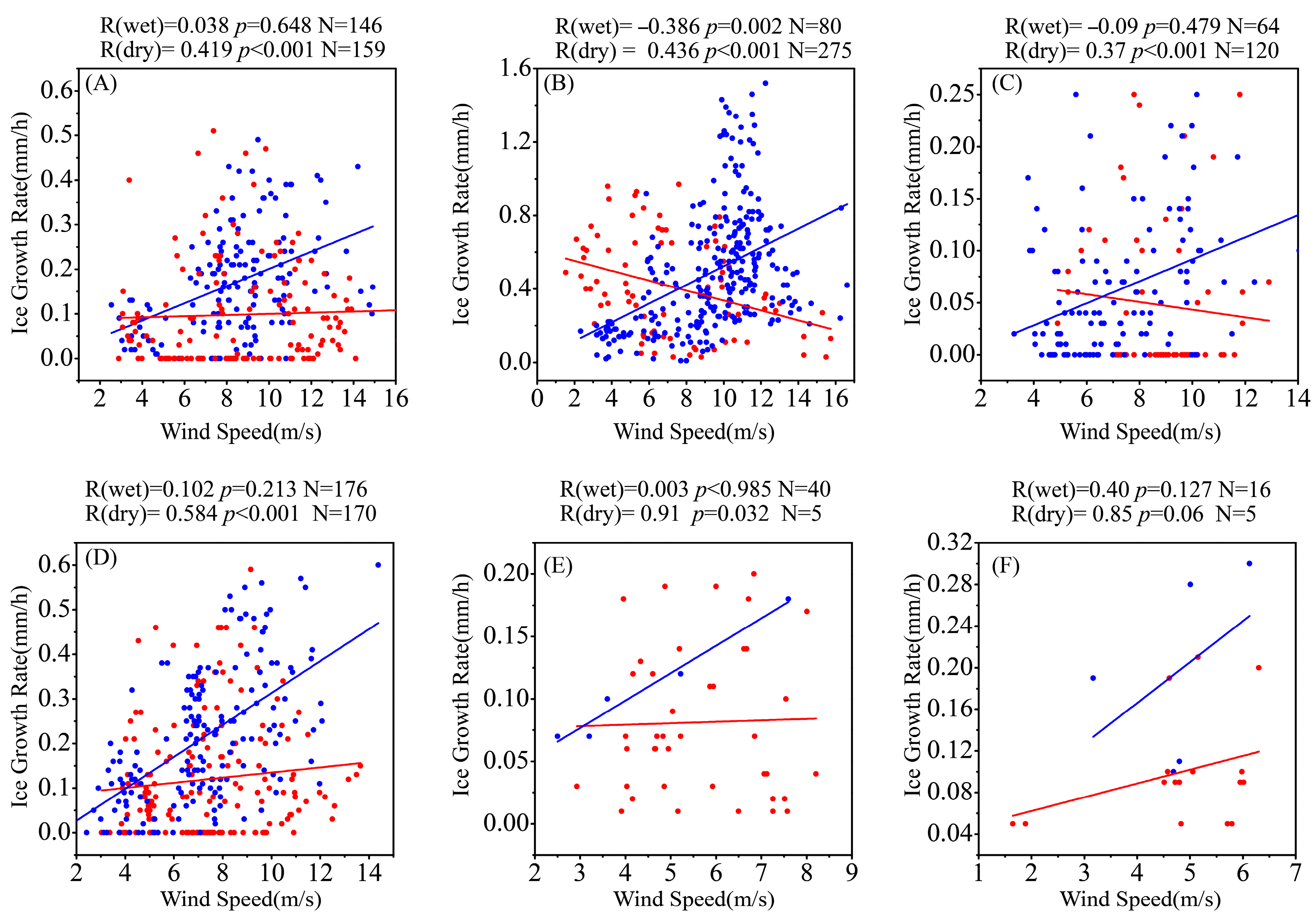
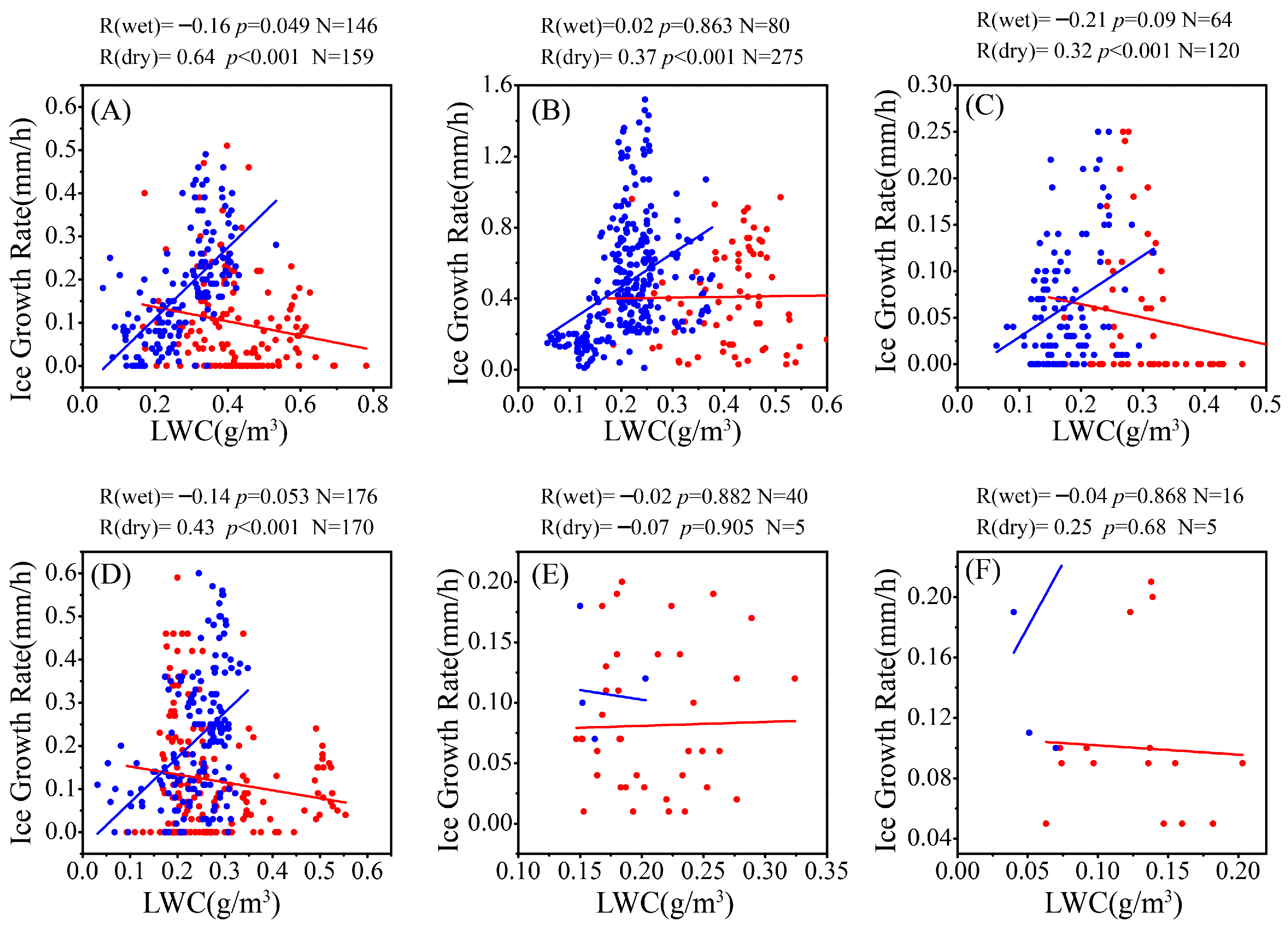
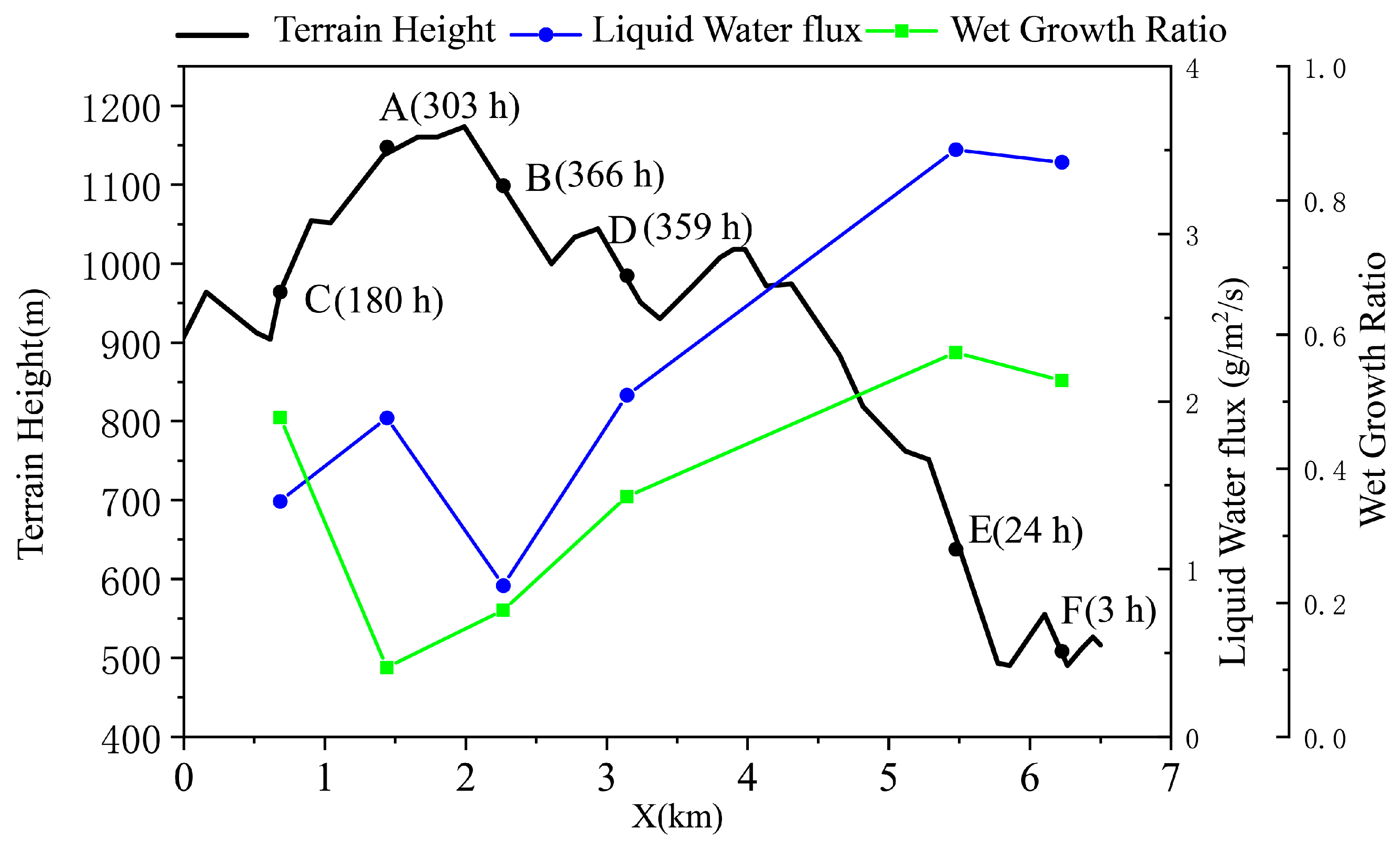
Disclaimer/Publisher’s Note: The statements, opinions and data contained in all publications are solely those of the individual author(s) and contributor(s) and not of MDPI and/or the editor(s). MDPI and/or the editor(s) disclaim responsibility for any injury to people or property resulting from any ideas, methods, instructions or products referred to in the content. |
© 2024 by the authors. Licensee MDPI, Basel, Switzerland. This article is an open access article distributed under the terms and conditions of the Creative Commons Attribution (CC BY) license (https://creativecommons.org/licenses/by/4.0/).
Share and Cite
Zhou, F.; Zhang, H.; Pan, H.; Li, H.; Geng, H.; Lu, Z.; Han, Y.; Liu, W. Impact of Meteorological Factors on the Wire Icing Thickness and Growth Rate in Mountain Areas under Dry and Wet Growth Patterns. Atmosphere 2024, 15, 875. https://doi.org/10.3390/atmos15080875
Zhou F, Zhang H, Pan H, Li H, Geng H, Lu Z, Han Y, Liu W. Impact of Meteorological Factors on the Wire Icing Thickness and Growth Rate in Mountain Areas under Dry and Wet Growth Patterns. Atmosphere. 2024; 15(8):875. https://doi.org/10.3390/atmos15080875
Chicago/Turabian StyleZhou, Fangrong, Haipeng Zhang, Hao Pan, Hao Li, Hao Geng, Zhengqi Lu, Yongxiang Han, and Weijia Liu. 2024. "Impact of Meteorological Factors on the Wire Icing Thickness and Growth Rate in Mountain Areas under Dry and Wet Growth Patterns" Atmosphere 15, no. 8: 875. https://doi.org/10.3390/atmos15080875
APA StyleZhou, F., Zhang, H., Pan, H., Li, H., Geng, H., Lu, Z., Han, Y., & Liu, W. (2024). Impact of Meteorological Factors on the Wire Icing Thickness and Growth Rate in Mountain Areas under Dry and Wet Growth Patterns. Atmosphere, 15(8), 875. https://doi.org/10.3390/atmos15080875




